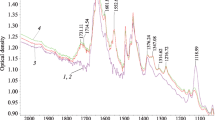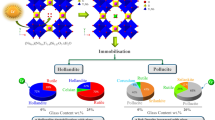Abstract
In order to develop radiation resistant membranes for the treatment of high level waste (HLW), ceramic tubular membranes were prepared by incorporating varying amounts of ammonium molybdophosphate (AMP), known for efficient Cs(I) uptake from acidic feeds, for the recovery of radio-caesium. The sorption of Cs(I) onto the membrane increased linearly with increasing the AMP content (10%–40%). Radiation stability of the membranes was evaluated by exposing them to gamma radiation obtained from a 60Co source. The composite ceramic material showed excellent radiation stability without any morphological change up to 1100 kGy, indicating its potential application in radioactive waste treatment. For 10% AMP loaded ceramic membrane, the Cs(I) sorption decreased linearly with radiation dose. However, Cs sorption was not altered up to 1100 kGy dose for 20% and 40% loaded AMP.







Similar content being viewed by others
References
Choppin GR, Morgenstern A (2000) Radionuclide separations in radioactive waste disposal. J Radioanal Nucl Chem 243:45–51
Zakrzewska-Trznadel G, Harasimowicz M, Chmielewski AG (1999) Concentration of radioactive components in liquid low-level radioactive waste by membrane distillation. J Membr Sci 163:257–264
Rudenko LI, Khan VE (2005) Membrane Methods for treating liquid radioactive wastes from the shelter to remove transuranic elements. Radiochemistry 47:89–92
Chmielewski AG, Harasimowicz M (1995) Application of ultrafiltration and complexation for the treatment of low-level radioactive effluents. Sep Sci Technol 30:1779–1783
Foust H, Ghosehajra M (2010) Sizing an ultrafiltration process that will treat radioactive waste. Sep Sci Technol 45:1025–1032
de Vos RM, Verweij H (1998) High-selectivity, high-flux silica membranes for gas separation. Science 279:1710–1711
Liu Y, Zhu W, Guan K (2018) Preparation of high permeable alumina ceramic membrane with good separation performance via UV curing technique. RSC Adv 8:13567–13577
Amin S, Abdallah H, Roushdy M, El-Sherbiny S (2016) An overview of production and development of ceramic membranes. Int J Appl Eng Res 11:7708–7721
Ding G, Qi H, Xing W (2008) Effect of particle size distribution of raw powders on the pore structure of macroporous alumina supports. Membr Sci Technol 28:23–27
Li D, Zhu Q, Cui S (2012) Preparation and characterization of circular plate-shaped porous alumina ceramic membrane support. Chin J Environ Eng 6:941–944
Zhang F, Liu Y, Xie W (2006) The effect of PVA on the properties of alumina support. Membr Sci Technol 26:95–98
Yang GCC, Tsai C (2008) Effects of starch addition on characteristics of tubular ceramic membrane substrates. Desalination 233:129–136
Liu S, Gavalas G (2005) Oxygen selective ceramic hollow fiber membranes. J Membr Sci 246:103–108
Ansari SA, Kandwal P, Mohapatra PK (2015) Handbook of membrane separations. Chemical, pharmaceutical, food and biotechnological applications, 2nd edn. CRC Press, Boca Raton, pp 787–812
Ambashta RD, Sillanpaa MET (2012) Membrane purification in radioactive waste management: a short review. J Environ Radioact 105:76–84
Zakrzewska-Trznadel G, Harasimowicz M (2002) Removal of radionuclides by membrane permeation combined with complexation. Desalination 144:207–212
Zaki EE, Gasser MS, Aly HF (2000) Separation of cesium from intermediate level waste solutions using zirconyl tungstate ceramic-supported membranes. J Radioanal Nucl Chem 246:361–367
Šebesta F, Steful V (1990) Composite ion-exchanger with ammonium molybdophosphate and its properties. J Radioanal Nucl Chem 140:15–21
Todd TA, Mann NR, Tranter TJ, Šebesta F, John J, Motl A (2002) Cesium sorption from concentrated acidic tank wastes using ammonium molybdophosphate-polyacrylonitrile composite sorbents. J Radioanal Nucl Chem 254:47–52
Park Y, Lee Y-C, Shin WS, Choi SJ (2010) Removal of Cobalt, Strontium and Cesium from radioactive laundry waste water by ammonium molybdophosphate—polyacrylonitrile (AMP-PAN). Chem Eng J 162:685–695
Figueiredo BR, Cardoso SP, Portugal I, Rocha J, Siulva CM (2018) Inorganic ion exchangers for cesium removal from radioactive wastewater. Sep Purif Rev 47:306–336
Wu Y, Lee CP, Mimura H, Zhang X, Wei Y (2018) Stable solidification of silica based ammonium molybdophosphate by allophone: application to treatment of radioactive cesium in secondary solid waste generated from Fukushima. J Hazard Mater 341(2018):46–54
van Smit JR, Jacobs JJ, Robb W (1959) Cation exchange properties of the ammonium heteropoly acid salts. J lnorg Nucl Chem 12:95–103
Zhaoyi T, Zhaoya H, Dong Z, Xiaolin W (2014) Structural characterization of ammonium molybdophosphate with different amount of cesium adsorption. J Radioanal Nucl Chem 299:1165–1169
Spinks JWT, Woods RJ (1990) An introduction to radiation chemistry, 3rd edn. Wiley, New York, pp 285–296
Mahindra Ch, Sathya Sai PM, Anand Babu C, Revathy K, Rajan KK (2015) Analysis and modelling of fixed bed sorption of cesium by AMP-PAN. J Environ Chem Eng 3(2015):1546–1554
Raut DR, Mohapatra PK, Wattal PK, Manchanda VK (2012) Effect of irradiation on AMP based resins for cesium separation from HNO3 feed solutions: batch and column studies. J Radioanal Nucl Chem 292:661–666
Acknowledgements
The authors thank Dr. P.K. Pujari, Assoc. Director, Radiochemistry & Isotope Group for his constant encouragement and keen interest in this work. One of the authors (PKM) gratefully acknowledges the support given by Board of Research in Nuclear Sciences for financial support under the DAE-SRC grant.
Author information
Authors and Affiliations
Corresponding author
Ethics declarations
Conflict of interest
The authors declare no conflict of interest.
Additional information
Publisher's Note
Springer Nature remains neutral with regard to jurisdictional claims in published maps and institutional affiliations.
Rights and permissions
About this article
Cite this article
Ansari, S.A., Sahoo, G.C., Dey, S. et al. Radiation stability of ceramic tubular membranes containing ammonium molybdophosphate (AMP) for the application of radio-cesium recovery from radioactive wastes. J Radioanal Nucl Chem 326, 1631–1638 (2020). https://doi.org/10.1007/s10967-020-07449-2
Received:
Accepted:
Published:
Issue Date:
DOI: https://doi.org/10.1007/s10967-020-07449-2




